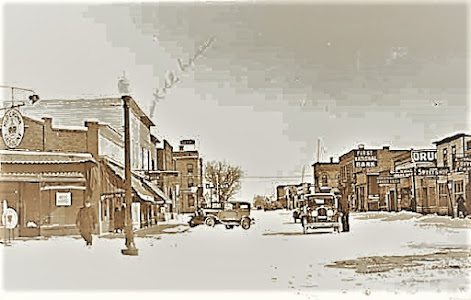More on the Glaeve family and Cass Lake Minnesota
His parents, both born in Illinois, still clung to their German language and traditions. They wanted to name him Reinhold Otto. But this was 1917 and these were sensitive times for people of German ancestry in this country. The local Lutheran pastor cautioned them against the name because it sounded “Too German” and thus Reynold was their next choice. The conflicting birth dates and the naming were two of Dad’s favorite, and oft repeated stories.
Cass Lake's main business street, 1910
Reynold was the last child born to Fred and Ella and the only one born in Cass Lake, or Minnesota for that matter. Marie, Eleanore, Emil “Freddie”, Martin and Martha were all there to welcome a new brother. Photographs show the children in their hand-me-down clothes. Dad was the third boy to wear the “boy clothes” and appears to have dipped into the girl’s box at times to complete his outfits.
Times must have been hard and the work of clearing stumps from logged-over land a back-breaking undertaking. In the winter many of the men worked in the lumbering camps to provide some needed income for their families. We assume that Grandpa also worked in the camps. Dad told of him working at the local Cass Lake saw-mill. It was German tradition that the whole family, including the women and children, help in the fields and garden. It is doubtful that the farm was profitable enough to provide much, if any, additional money. When Marie and Eleanore were old enough, they were employed, probably as house-keepers, at a local town hotel called the Endion.
Endion Hotel Cass Lake, Minnesota
The photos of the farm house and out –buildings show a very humble place. The family still used horses for field work and for transportation. With Grandpa at the reins they made trips to the neighbors, to the lake for fishing and to worship services at the Lutheran Church. In the winters, the children were huddled together in the back, under buffalo robes. Stones would have been heated in the wood burning stove for the trip and re-heated where-ever they were visiting for the return trip.
Trinity Lutheran Church in Cass Lake
from some written memories of Reynold Glaeve
"The barn was really two in one, a cow barn with stalls for our twelve cows and a little pen for the calves, and a horse barn for our three horses. Hay was also stored here, short term. The bulk of the hay was stored in a loft above the barn, and in hay stacks in the field. A shelter was attached to the barn a couple of years before we moved to town."
"There was also a chicken house for about twenty five or more chicken[s], boxes fastened [to] the wall for egg production. We also had a granary, the only building of dimensional lumber. for storage of corn and oats, feed for the animals. A small pump house built of stones and set down in the earth with a water tank were milk w[h]ere milk cans could be kept before it would be picked up and taken to town for sale."
"For a little kid, town was a long journey, a two hour ride one way in a buggy drawn by one horse....In 1920 it was unusual to meet more than one car on the road in only two hours, and when you did, the horse would go crazy, and it was difficult to prevent it from running away"
At some point the family moved off the farm into the town of Cass Lake. We have not been able to establish these dates nor have we been able to find an address or the land transactions. The village was smack in the middle of the Cass Lake Indian Reservation and many of their playmates were children of the local Ojibwe families. When not at school the children found fun at the mill pond where they swam, fished and skated.
Street Scene Cass Lake Minnesota





No comments:
Post a Comment